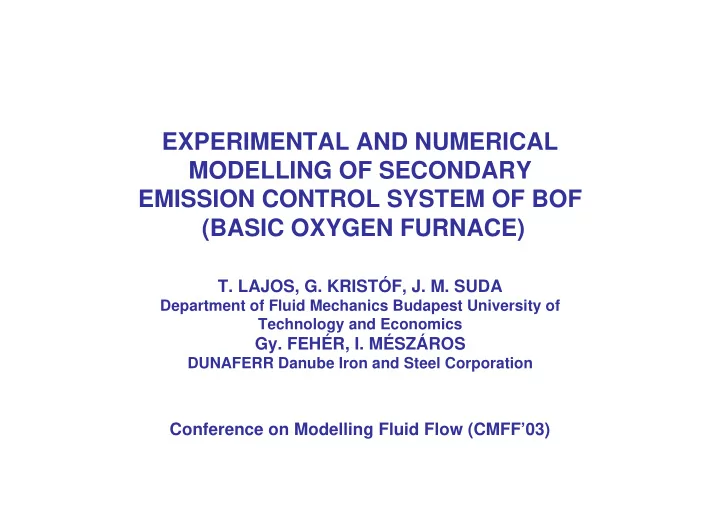

EXPERIMENTAL AND NUMERICAL MODELLING OF SECONDARY EMISSION CONTROL SYSTEM OF BOF (BASIC OXYGEN FURNACE) T. LAJOS, G. KRISTÓF, J. M. SUDA Department of Fluid Mechanics Budapest University of Technology and Economics Gy. FEHÉR, I. MÉSZÁROS DUNAFERR Danube Iron and Steel Corporation Conference on Modelling Fluid Flow (CMFF’03)
Secondary emission of BOF technology The most serious air pollution of steel production occurs when hot iron is charged from a ladle into the converter vessel filled partly with scrap (mass of solid pollutants is 10 − 20 kg/cycle, concentration: 1- 2 g/m 3 ). The space available for the hood capture system is limited by the operation of crane. Aim of investigation was to find appropriate hood capture system and to predict its capture efficiency.
Solution of the problem: combined application of model experiment and CFD Flow characteristics: temperature of hot gases is appr. 1000 ° C. Gas velocity in the opening of the vessel of 14 D=2.6 m diameter is about 9 NYM2 7 8 − 10 m/s. NYM4 HM2 10 Hot gas jet flow is strongly 13 NYM3 influenced by buoyancy NYM1 11 SM3 8 TM2 force. SM2 HM4 6 SM1 HM3 HM1 12 5 High temperature exhaust 4 gas escaping the converter HM5 was modelled with hot air in NYM3 a 1:20 scale model. 1 2 3 TM1
Experimental setup
Considerations of modelling a) Flow similarity: the buoyancy forces influence the shape of hot gas jet b) Evaluation of capture efficiency: simple and reliable method for evaluating different hood and exhaust variations c) Flow visualisation
a) Flow similarity inertia/buoyancy forces at full scale and model should be identical ⇒ model discharge velocity can be determined from full scale discharge velocity, model scale and temperature ratio ∆ 2 ρ v D T = v v M M = g 2 Fr ) , ( ⇒ Fr M =Fr M ∆ − D ρ ρ g D T a g b) Evaluation of capture efficiency heat flux entering the capture hood CE = heat flux discharged from the converter vessel At measuring heat flux entering the capture hood thermal stratification of air removed by the hood should be considered : a) either by measuring velocity and temperature distribution or b) by mixing of air layers of different temperatures
Mixing of stratified flow Numerical simulation of the flow in a labyrinth (FLUENT 5.5) c) Flow visualisation by transilluminating the hot gas flow
Numerical simulation of flow in hood capture system model a) The geometry of simulation model was scaled after the experimental setup. Outlet air velocity and temperature have been taken from the laboratory scale model. b) Symmetry assumption with respect to the mid-plane of the facility was employed. The grid consisted of approximately 250,000 tetrahedral cells. c) Hot gas was introduced to the computational domain through a velocity inlet, and pressure outlets were applied on the remaining boundary surfaces. d) Air density was computed from the incompressible ideal gas model as a function of local temperature. e) Time dependent simulation was applied and turbulent transport was computed with Renormalisation Group k − e model.
Calculated flow field of hot gas jet (FLUENT 5.5) Velocity vectors and pathlines are coloured by velocity magnitude. Temperature distribution belongs to a given phase of the charging process.
Influence of relationship of mass flows q m,out [kg/s] = 14,5 14,5 7,25 q m,exh [kg/s] = 136 68 68 q m,out /q m,exh = 0,107 0,213 0,107 CE [%] = 86 57 100 The simulation results prove the significance of similarity requirement: Fr m =Fr
Analyses of the charging process a) Capture efficiency was mostly affected by the position of charging ladle. b) When using the hood of optimized geometry CE=0.87 was measured without charging ladle. In the first phase of the charging process, when ladle approaches the jet, the capture efficiency decreases to CE min =0.54 because of interaction between the jet and ladle. c) At the end of the charging when the open-cross section of the ladle approaches the vertical, the capture efficiency increases rapidly and reaches 100%. So the average capture efficiency (estimated to 75 − 85%) d) depends also on the pace of the charging determined by the crane operator. To improve the capture efficiency, the construction of the charging vessel should be changed in order to avoid the “adherence” of the jet to the charging ladle.
Conclusions • Experimental investigations on a scale model are reliable tools for development of air pollution control systems in metallurgy, removing in general hot gases. In order to ensure flow similarity, the Froude number for model and prototype should be identical. • Measurement and comparison of exhaust and discharge heat fluxes proved to be a suitable method for determining the capture efficiency of the pollution control system. • Interaction between the jet and charging ladle influences the capture efficiency significantly. • The results of the 3D numerical simulation agreed well with the results of measurements, so CFD can efficiently be used in solving similar air pollution control problems in metallurgy.
Recommend
More recommend